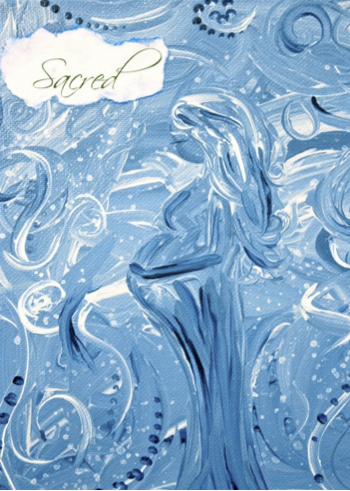Water Keepers
Exploring the roles of doula, midwife and obstetrician in childbirth
Cat’s First Birth Story
My client’s name is Cat (I offered to use an anonymous name but she read this and felt proud of her story so wanted to own it with her real name) and she had a very intense first birth experience that was not without trauma. Her waters had broken but was not followed by regular contractions, so she went into the hospital, and after several hours of walking and breast pumping to try and stimulate labor, was given pitocin to induce labor. She remembers very little about what happened next. She has the odd memory of her doula (who was her doula’s back up) giving her instructions for various positions. About six hours later, she delivered her baby girl. Shortly after, she was in the tub and given some time alone, and she remembers feeling very upset and crying because she didn’t understand what had just happened. This laid the groundwork for a very tough postpartum period with the ultimate diagnosis of postpartum PTSD. Essentially, I came to understand that she disassociated from and had very little memory of her first birth. When I first met with her and her husband, I asked them to tell me in detail all they could remember about this experience, as clearly it had the ability to impact her second birth. Her husband filled in the gaps, and then her underlying emotional state leading up to this first birth began to unfold. She had a very fraught and broken relationship with her mother and the realization that she was choosing to become a mother herself, led to a significant amount of fear and anxiety leading up to her first birth.
This information is, from my perspective as her doula, absolutely essential to my ability to genuinely and appropriately support her in labor. We spoke at length about what helped her overcome her PTSD and how important self-care is before, during and after this new birth experience. Most importantly, we were able to identify all her coping skills and examples of her own strength in handling such an intense emotional reality – and how that strength could serve her and allow her to bring who she was NOW, into this new birth. We identified specific breathing techniques that helped her relax and mantras/affirmations that she liked that I could remind her of when labor was happening. I showed her husband pressure points they could practice so they knew what to do to help early labor unfold calmly. We also talked about the importance of arranging postpartum support, which triggered deeper feelings of not being ‘adequate’ enough to cope without help and not wanting to be overly reliant on others. I gently reminded her that no one can do this alone and that she deserved all the help and support she needed. The tears flowed. She made arrangements for a postpartum doula as well as for her brother to come and stay with her and help with her daughter.
Cat’s Second Birth Story
When her waters broke this time, she again had no immediate contraction pattern and she and I were in touch over the phone regularly as the hours unfolded. She went to her prescheduled midwife appointment and I reminded her that it was ok to ask to be able to go home again IF she didn’t want to stay (as is typically recommended after waters have ruptured given the increase risk of infection over time). Had she been under the care of an OB, it would be highly unusual for her to be granted this freedom. Her midwives, to their credit, honored her preference and they agreed that she could go home with the plan to return to hospital by 5pm if her labor was still not underway. She was very happy and relieved about this and returned home, where she was able to relax, eat lunch, take showers and arrange for the care of her 2 year old daughter.
When 5pm approached, she was just starting to get some stronger contractions that she needed to work through. I suggested she call the midwives and tell them that she would give it another hour or so and then come in. As I waited for Cat and her husband’s arrival, I was able to check in with the nurse and midwife – and I realized that they had no idea of the detail of Cat’s dissociative experience surrounding her first birth. I gave them a general summary without disclosing anything too personal that was shared in confidence with me – and focused on the importance of keeping Cat present and focused on what was happening in the moment. They were very responsive to this information and the midwife, especially, was very clear and present and didn’t leave Cat’s side as so often happens in a hospital setting with multiple labring women to care for.
When Cat arrived, she was clearly in active labor. We got her on the birthing ball and her husband put on the dance music that was really helping her focus. She was literally swaying her hips and singing Arianna Grande (she was tempted to have me omit this particular detail but decided to own it all!). I remember smiling and feeling so in awe of and proud of her obvious ability to step into and truly experience this birth. She had every reason in the world to feel afraid and overwhelmed, but instead, here she was smiling and clearly amazed at what her body was doing. I kept my hands on her back and regularly asked her if she was ‘with us’ and connected to her body. It was obvious that she was. We were all pulled into the vortex of her birthing energy. When things seemed to intensify, we suggested she get in the shower. After 10 minutes, she was clearly feeling pressure and we got her on the bed, just in time to announce that she was very close to having her baby. This was both shocking and exhilarating for Cat. Exactly one hour after her arrival, she delivered her baby boy while on her hands and knees. No IV, no pitocin, no nothing other than her very associated self.
Fast births can be very shocking and I was aware of the risk of this shock triggering the very different kind of shock she experienced the first time – which I came to understand as the shock of returning to the body she had left only to discover it was no longer pregnant. This time was entirely different. She had her baby on her chest and a permanent smile on her face, literally incredulous as to what has transpired in so little time.
Cat’s bleeding seemed to subside as per usual, but then as she got in the shower, it clearly hadn’t, so the midwife called for the OB to come and consult. Postpartum pitocin had already been administered so the increase in bleeding was concerning. They wanted to rule out the possibility of retained placenta. By this time, Cat’s husband was lying down with his baby so the doctor could assess Cat’s uterus. Now, this procedure is not fun as it involves reaching your entire forearm into the uterus to feel around for any placenta that may be still inside – preventing the complete contraction of the uterus and thus risking hemorrhage. When the OB walked into the room, her manner was abrupt and her questions directed entirely at the midwife. Cat was clearly put off and she looked at me as if to say, ‘who is this woman and what’s with her attitude?’. Now I happened to know that this doctor was head of obstetrics at this hospital and had a stellar reputation. I reminded Cat that she was here to make sure that she was ok and able to recover safely and not lose too much blood. I asked her to keep her focus on me and that we breathe together while I held pressure points to help cope with the intense discomfort of having her uterus scooped out. Cat was fine and the doctor was able to rule out retained placenta. She stayed associated with what was happening and kept her focus on her breath and baby, sleeping peacefully on her husbands chest.
Cat’s second birth truly highlights the different roles doulas, midwives and OB’s play as we support women in childbirth. My connection with Cat and knowledge of her emotional history of trauma had been established in my non clinical role as her doula. I had spent at least 5 hours in total with her and her husband and daughter in the comfort of their home prior to her birth. My understanding of her past birth allowed her midwife to support her in a more personal and informed manner. Her midwife was trained to know the signs of possible retained placenta and make sure the OB was called in to assess and ultimately treat a possibly dangerous hemorrhage if needed. It was not the OB’s job to know about Cat’s history of emotional trauma and it was not her job to notice the clear panic in Cat’s eyes when she entered the room and help her slow down her breathing and stay connected to her body. That was my job.
In the days prior to our modern medicalization of birth, my role as doula would have been a natural extension of both the community/home based midwives as well as the close friends and family of the birthing woman. Birth is and never has been solely a clinical event. All women deserve not only well trained midwives and/or obstetricians to ensure a safe birth – but they also deserve the support that recognizes that this is a deeply mental, emotional and psychological process with long lasting repercussions for the birthing woman, not to mention for her baby and the family that she will ultimately hold together as so many women do.
Larger perspective
As I write and reflect back on Cat’s birth experiences, I can see the significance of water in both its ability to trigger the fear and anxiety of an unknown world as well as bring us back to ourselves. After her waters broke the first time, her understandable fear and anxiety overwhelmed her ability to stay connected to the incredible physicality of birth. Once she was in the bath immediately afterwards, the water brought her back, and the floodgates of shock and emotion opened. For her second birth, the breaking of her waters released Cat, the Mother – the woman she became as she healed and overcame past trauma, into an entirely new experience. One where she stayed connected to and was able to experience the power that she had all along.
Doulas exist because women are wise and waking up to this power that is inherent in their experience of birth.
While birth, for the majority of women, may largely still take place in hospitals, doulas are there not to stand in the way or prevent the midwives and OB’s from doing their job, but to offer unconditional support in recognition of the woman doing the work.
Indeed, our very presence serves as a tacit reminder to everyone in the room that something significant if not sacred is happening, and that the birthing woman’s power is hers to keep.
Women are the keepers of the water.
Water is life.
Life is sacred.
Women are sacred.
[hr]


